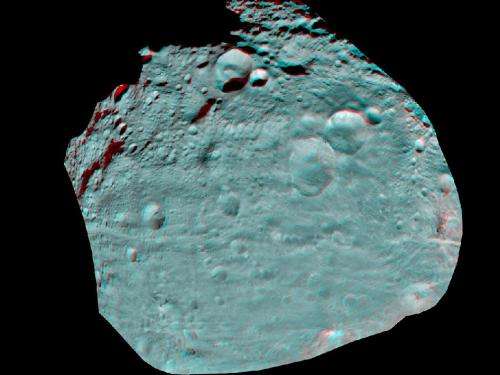Dawn beams back asteroid science data

(PhysOrg.com) -- The Dawn spacecraft has completed a graceful spiral into the first of four planned science orbits during the spacecraft's yearlong visit to Vesta. The spacecraft started taking detailed observations on Aug. 11 at 9:13 a.m. PDT (12:13 a.m. EDT), which marks the official start of the first science-collecting orbit phase at Vesta, also known as the survey orbit.
Survey orbit is the initial and highest orbit, at roughly 1700 miles (2700 kilometers) above the surface, which will provide an overview or "big picture" perspective of the giant asteroid.
The primary objective of survey orbit is to image the surface with near-global coverage in visible and infrared wavelengths with the mapping spectrometer, also known as VIR. Dawn also will be using its framing camera to collect image mosaics that complement the VIR spectral data to produce geologic and compositional maps of Vesta's surface. Ultrasensitive measurements of the spacecraft's motion using radio signals will allow improved understanding of the giant asteroid's gravity field. Dawn's gamma ray and neutron detector will continue to collect background data.
The survey phase is planned to last 20 days. Each orbit takes almost three days, which will provide the spacecraft seven trips around Vesta. After survey orbit, Dawn will resume thrusting, taking about a month to spiral down gently to its next science orbit for an even closer view. That orbit, known as High Altitude Mapping Orbit, or HAMO, begins in late September. Dawn will spend about a month in HAMO, circling around Vesta in half a day, rather than three. Dawn will orbit more than 60 times during HAMO, allowing the camera to fully map the illuminated portion of Vesta at even higher resolution, and enable the science team to generate stereo images.
Dawn launched in September 2007 and arrived at Vesta in July 2011. Following a year at Vesta, the spacecraft will depart in July 2012 for Ceres, where it will arrive in 2015. Dawn's mission to Vesta and Ceres is managed by the Jet Propulsion Laboratory, Pasadena, Ca., for NASA's Science Mission Directorate in Washington.
More information: For more information about Dawn, visit: www.nasa.gov/dawn
Provided by JPL/NASA





















